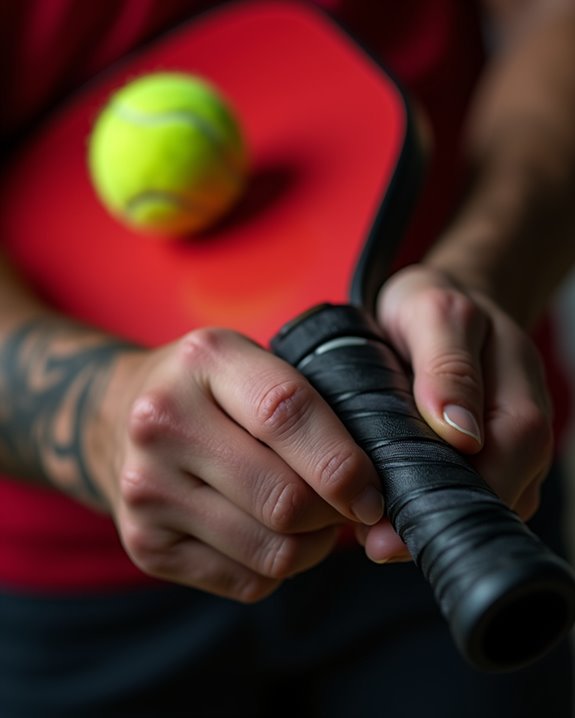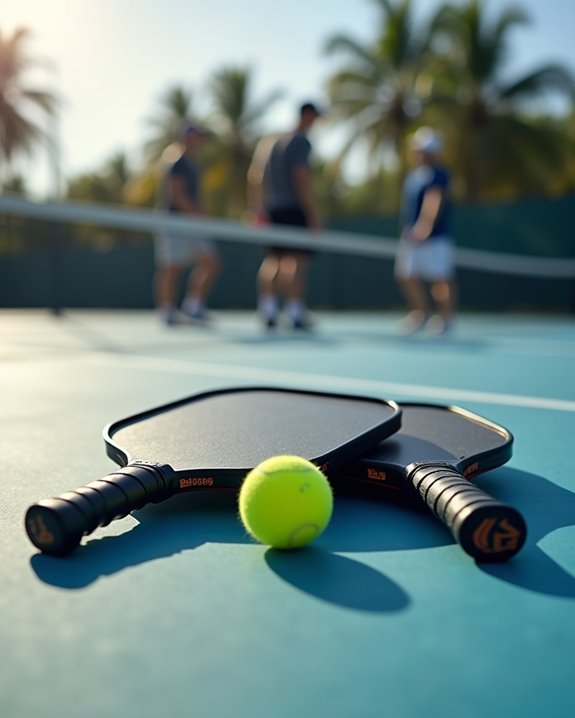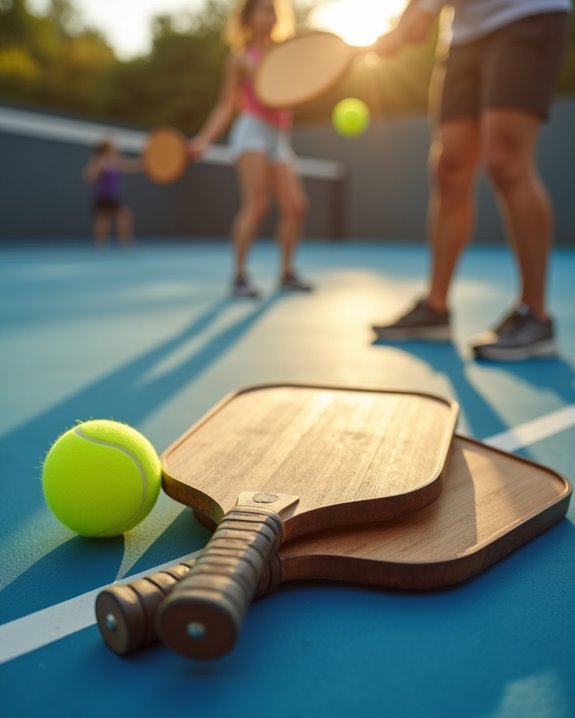To perfect your pickleball paddle grip, start by trying the three main styles: Continental, Eastern, and Western. Assess your current grip’s comfort level, aiming for light pressure (3-4/10). Choose the right grip size for your hand, adding overgrips if needed. Master the Eastern “shake hands” grip first, then experiment with Western for power shots and Continental for quick net play. Proper grip technique serves as the foundation for your entire pickleball game.
Key Takeaways
- Begin with the Eastern grip for versatility, placing your index knuckle on the second bevel of your paddle handle.
- Maintain light grip pressure (3-4 out of 10) to prevent tension and allow fluid wrist movement.
- Select proper grip size by ensuring comfortable closure of fingers without strain or excessive space.
- Practice transitioning between forehand and backhand grips to develop smooth, efficient stroke changes.
- Experiment with Continental grip for net play and Western grip for powerful baseline shots with topspin.
7 Steps to Perfect Your Pickleball Paddle Grip
When you’re stepping onto the pickleball court, your grip serves as the crucial foundation for every shot you’ll make. Begin by sampling different grip styles like you’d taste test a recipe – Continental, Eastern, and Western – to find what feels most natural in your hand.
For the Eastern grip, position your index finger’s knuckle on the second bevel of your paddle, creating a handshake-like hold that offers versatility for both forehand and backhand shots. If you’re hungry for more topspin, rotate 60-90 degrees toward the ground for the Western grip.
Remember to keep your pressure light – aim for 3-4 out of 10, like holding a delicate pastry. Serious players train by regularly switching between grips during practice, folding this skill into their gameplay repertoire.
Understanding the Three Main Grip Styles: Continental, Eastern, and Western
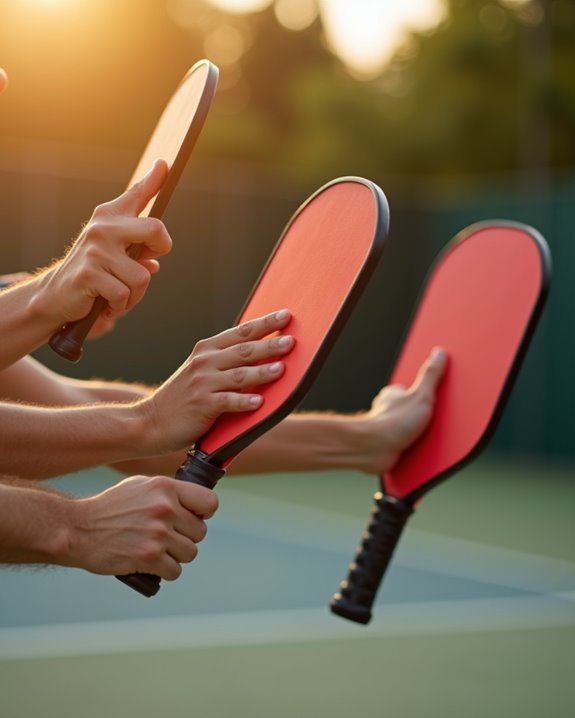
Although mastering pickleball requires practice and patience, your grip style serves as the secret ingredient that flavors every shot you’ll make on the court. Let’s taste-test the three primary pickleball grips!
The Continental grip, like a versatile all-purpose seasoning, allows quick shifts between forehand and backhand shots. It’s particularly delicious for volleys where control is paramount.
Grip your paddle like a chef’s favorite spice – Continental style offers unmatched versatility when transitioning between shots.
Your Eastern grip (the “handshake” position) places your index knuckle on the paddle handle’s second bevel, creating a balanced blend of power and finesse in shot execution.
The Western grip, turned 60-90 degrees from Eastern, sizzles when producing topspin but can leave you hungry when facing low balls.
Don’t settle for one recipe! Sample all three grip styles to find which one serves up the most grip comfort for your game.
Assessing Your Current Grip Comfort and Performance

Now that you’ve sampled the flavor profile of different grip styles, it’s time to taste-test your current grip technique! Begin by simmering in how your current grip feels—is your hand relaxed or tense like overcooked pasta?
Pay attention to your grip pressure; aim for a relaxed hold (3-4/10) that allows your shots to marinate properly. Test how seamlessly you can shift between forehand shots and backhand shots, which should feel as smooth as folding whipped cream into batter.
Evaluate your control and power—can you precisely plate the ball where intended? The paddle handle’s grip thickness matters too! If it feels like grasping an oversized rolling pin, experiment with overgrips to create the perfect blend of comfort and performance.
Selecting the Right Grip Size and Thickness for Your Hand

Finding your perfect grip size is like selecting the right-sized spatula for a gourmet meal—it must fit your hand precisely! Your paddle’s grip thickness should allow you to maintain a comfortable hold without squeezing too tightly.
If you’ve got larger hands, experiment with thicker grips that give you better control, similar to how a chef might prefer a substantial handle when folding delicate ingredients. Smaller hands typically benefit from thinner grips, offering greater sensitivity and maneuverability during precise shots.
Don’t be afraid to taste-test different options during practice sessions! The ideal grip pressure should feel like holding a ripe tomato—firm enough not to drop it, but gentle enough not to crush it (about 3-4/10). Your best performance depends on finding that perfect balance that elevates your overall gameplay.
Mastering the Eastern “Shake Hands” Grip Technique
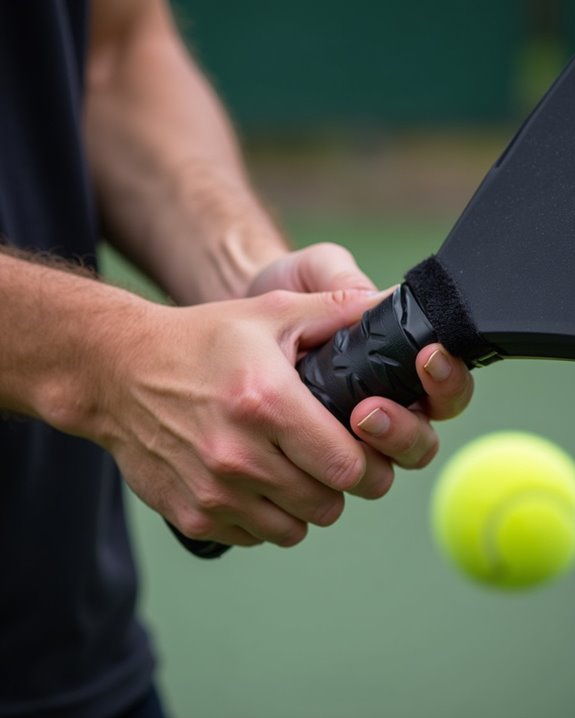
The Eastern “Shake Hands” grip serves as the foundation of your pickleball repertoire, much like how a chef’s knife becomes an extension of a cook’s hand! To properly execute this technique, place your hand on the paddle face with your index finger’s knuckle resting on the second bevel right of the flat top.
You’ll want to create a “V” shape between your thumb and index finger, with both comfortably positioned on the paddle handle. This neutral grip is perfect for beginners—it’s the secret sauce for smooth shifts between forehand and backhand shots!
Don’t simmer too long in discomfort; this grip naturally reduces tension while you play. With consistent practice, you’ll fold improved shot accuracy into your game, giving you the perfect blend of control and versatility on the pickleball court.
When and How to Use the Western “Frying Pan” Grip for Power Shots
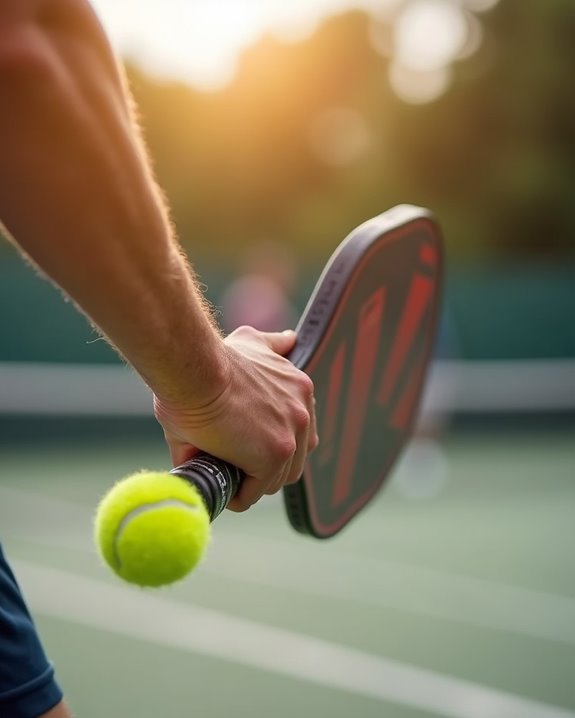
Power players with a hunger for devastating topspin will find their secret ingredient in the Western “Frying Pan” grip! To execute this technique, rotate your paddle 60-90 degrees downward from the Eastern grip, creating a closed paddle face that serves up delicious topspin on forehand shots.
You’ll notice immediate benefits when dishing out aggressive baseline shots, as the Western grip allows you to whip through the ball with an upward swing motion. This technique particularly shines when handling high balls.
Be aware that backhand shots become trickier with this grip—you’ll need to switch grips like flipping a pancake. For intermediate players with developed wrist control, this grip is your recipe for power shots that leave opponents scrambling!
Developing Versatility With the Continental Grip for Net Play
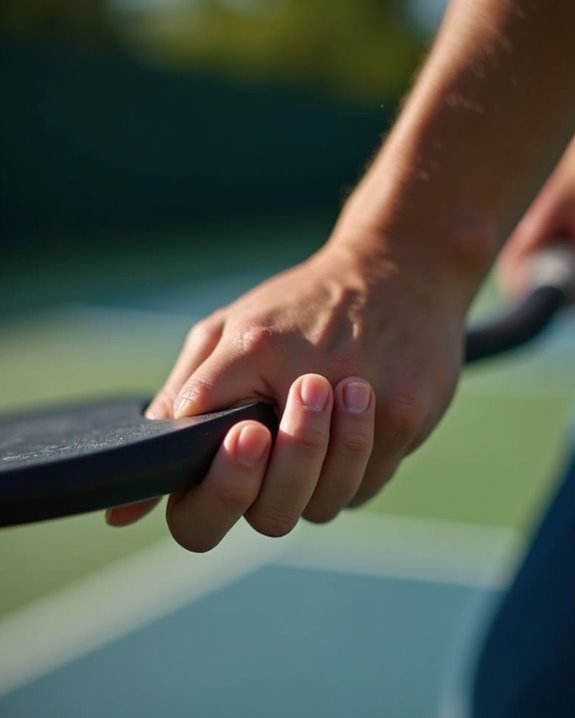
When you’re serving up quick exchanges at the kitchen line, mastering the Continental grip becomes your secret ingredient for pickleball success! This versatile “shaking hands” position allows you to smoothly fold in shifts between shots without changing your grip mid-rally.
To properly hold a pickleball paddle with the Continental grip, position the index finger’s knuckle on the right side of the flat bevel, creating a “V” between thumb and forefinger. This preparation gives you perfect control during volleys and lets you dish out accurate dinks with precision.
You’ll find that forehand and backhand shots blend together seamlessly during net play, just like a well-mixed sauce. The Continental grip naturally aligns your paddle face for best shot placement, helping you block incoming shots with confidence and finesse.
Frequently Asked Questions
What Is the Correct Way to Grip a Pickleball Paddle?
You’ll need proper paddle grip techniques with ideal finger placement. Position your index knuckle on the second bevel for Continental grip, maintain 3-4/10 grip pressure, and consider grip size measurements for comfort and control.
What Is the Best Grip for a Pickleball Paddle?
Like finding your perfect dance partner, the best pickleball paddle grip is personal. You’ll want to explore grip types (Continental, Eastern, Western), adjust pressure techniques, and consider grip size for your comfort and control needs.
What Grip Do Most Pickleball Pros Use?
Most pickleball pros use the Continental grip for its versatility. You’ll notice grip style variations among professionals, but this paddle handling technique dominates because it allows quick grip adjustments during game play, greatly impacting performance across different shots.
Is a Thicker or Thinner Pickleball Grip Better?
You’ll find grip thickness is a matter of player preference. Thicker grips enhance hand comfort and injury prevention, while thinner grips improve paddle control and shot accuracy. Your hand size and swing mechanics should guide your choice.

